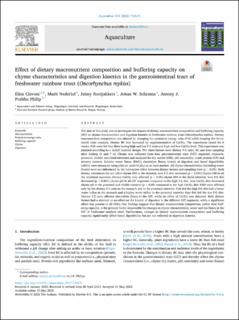Effect of dietary macronutrient composition and buffering capacity on chyme characteristics and digestion kinetics in the gastrointestinal tract of freshwater rainbow trout (Oncorhynchus mykiss)
Peer reviewed, Journal article
Published version
Permanent lenke
https://hdl.handle.net/11250/3102737Utgivelsesdato
2023Metadata
Vis full innførselSamlinger
- Articles [3011]
- Publikasjoner fra CRIStin [3061]
Sammendrag
The aim of this study was to investigate the impact of dietary macronutrient composition and buffering capacity (BC) on chyme characteristics and digestion kinetics in freshwater rainbow trout (Oncorhynchus mykiss). Dietary macronutrient composition was altered by changing the protein-to-energy ratio (P:E) while keeping the fat-to-starch ratio constant. Dietary BC was increased by supplementation of CaCO3. The experiment lasted for 6 weeks. Fish were fed four diets having high and low P:E ratio and high and low CaCO3 level. This experiment was planned according to a 2x2x2 factorial design. The three factors were dietary P:E ratio, BC and time sampling after feeding (3 and 7 h). Chyme was collected from four gastrointestinal tract (GIT) segments (stomach, proximal, middle and distal intestine) and analysed for dry matter (DM), pH, osmolality, crude protein (CP) and mineral content. Relative water fluxes (RWF), electrolyte fluxes, kinetic of digestion and faecal digestibility (ADCs) were measured using yttrium oxide (Y2O3) as an inert marker. All chyme characteristics (including water fluxes) were not influenced by the interaction effect between dietary factors and sampling time (p > 0.05). Both dietary treatments did not affect chyme DM in the stomach. Low P:E diet increased (p < 0.001) chyme DM in all the intestinal segments. Dietary CaCO3 only affected (p < 0.05) chyme DM in the distal intestine. Low P:E diet decreased (p < 0.001) chyme pH in all GIT segments compared to the high P:E diet. Low CaCO3 diet decreased chyme pH in the proximal and middle intestine (p < 0.05) compared to the high CaCO3 diet. RWF were affected only by the dietary P:E ratio in the stomach and in the proximal intestine. Fish fed the high P:E diet had a lower water influx in the stomach and a higher water influx in the proximal intestine than fish fed the low P:E diet. Dietary P:E ratio affected electrolyte fluxes in the GIT, while no effect of CaCO3 was detected. Both dietary factors had a minimal or no effect on the kinetic of digestion in the different GIT segments, while a significant effect was present in all ADCs. Our findings suggest that dietary macronutrient composition, rather than buffering capacity, is the primary factor responsible for changes in chyme characteristics, water and ion fluxes in the GIT of freshwater rainbow trout. Furthermore, changes in dietary macronutrient composition and buffering capacity significantly affect faecal digestibility but are not reflected in digestion kinetics.
